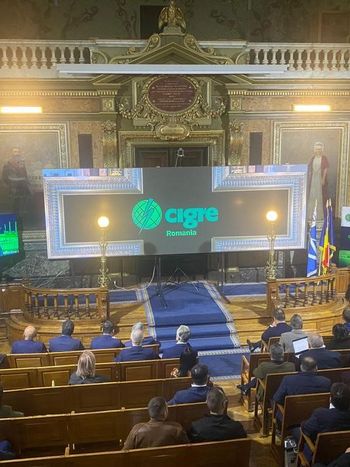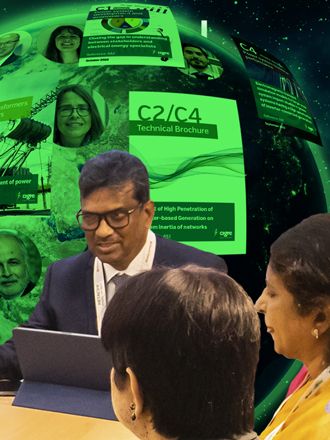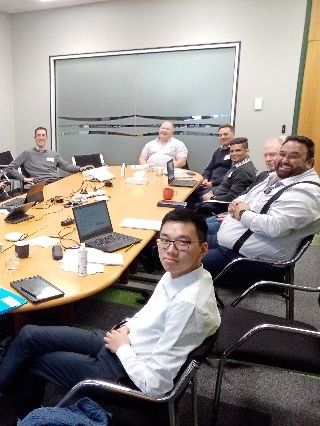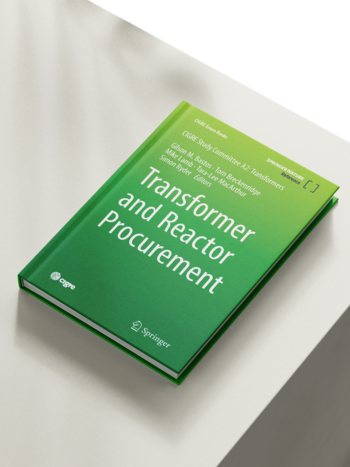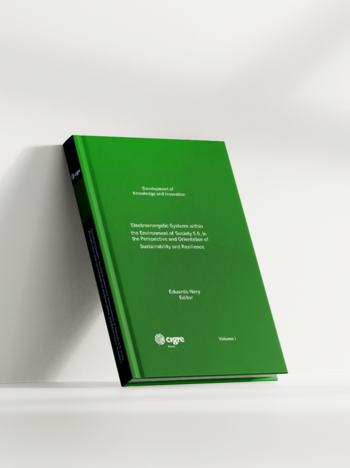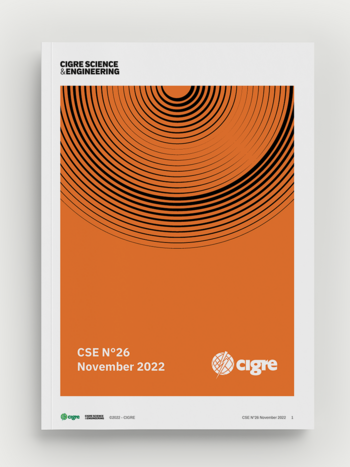CIGRE and IEEE Joint Panels on Blockchain
Blockchain technology is an elegant protocol enabling people to verify information and transact directly with one another in a trust-less environment. Three important and fundamental characteristics of blockchain are security, transparency, and immutability. These aspects are what make blockchain technology unique and a potential solution for energy and power applications.

Blockchain Technology
Blockchain is a decentralised ledger technology (DLT), where copies of the blockchain are kept among multiple participants in the network. Using a decentralised ledger increases transparency of records/data as there is greater visibility into transactions added to the blockchain. Transactions recorded on the blockchain are immutable because they cannot be deleted or changed, and an audit trail is created. Because there is not one copy of the ledger, the ledger and transactions being added to the blockchain have to be verified by network participants, and there is an auditable trail of transactions or records and the need for a central authority is reduced.
The absence of a third-party can result in cost, operational and market efficiencies. It could be applied to almost any market, in theory. In the energy sector, dozens of companies are attempting to use blockchain for asset registry, peer-to-peer trading, grid-level transactions, energy financing, electric vehicle charging and renewables tracking.
Before applying any new technology such as blockchain, it is important to reflect on whether it is solving a problem or helping to reduce the overall cost of a process or product. Technology is a tool that should complement systems, not constrain them.
CIGRE Working Groups
CIGRE have had two Working Groups looking at blockchain in power systems. The first was Working Group C5.30 which undertook a survey of which functions were being addressed in blockchain applications in operational systems. The emphasis was on studying real systems which were operational. This survey showed that trading and marketing was the most frequently used area.
A second Working Group was established in November 2020 and will be completing its work by March 2023. This Working Group took a more detailed look at the way blockchain was used in the most frequent area, namely energy trading.
IEEE Working Groups
IEEE have several streams of work involving blockchain. Their emphasis has been on educating energy professionals and in establishing standards for blockchain. These standards are vital if the industry is to achieve efficient implementations and good interoperability between systems. One of the difficult areas is interoperability between blockchain systems and a business’s conventional computer systems.
Joint Panels CIGRE/IEEE
here have now been three joint panels between CIGRE and IEEE from 2020 to 2022. The chair of all the panels has been David Bowker who has also been the convenor for the CIGRE blockchain Working Groups. Each of the panels was made up of experts from the CIGRE Working Group and from the IEEE.
The first joint panel of CIGRE and IEEE was held in August 2020 with the topics and panellists shown below:
- Electricity market challenges and disruptive innovation with emerging technologies, by Hannes Agabus, Tallinn University of Technology, Estonia
- CIGRE Blockchain Working Group Insights, by Hannah Davis, EPRI
- IEEE Blockchain in Energy Standards and Transactive Energy, by Claudio Lima, Ph.D., – Blockchain Engineering Council (BEC)
- Blockchain – The Future, by Umit Cali, PhD
The second joint panel of CIGRE and IEEE was held in August 2021. This was the Paris Centennial Session which had been anticipated to be a physical event but was converted to a virtual event due to Covid. During that event five topics were canvassed by the panel.
- Electricity market challenges and how to address them through market developments and emerging technologies
- CIGRE Blockchain – Current State (C5:30 WG Insights and Energy use Cases)
- IEEE Blockchain in Energy Standards and Transactive Energy
- IEEE Blockchain-enabled Transactive Energy (BCTE) program
- Blockchain – The Future
Joint Panel CIGRE/IEEE 2022
The third, and most recent, joint panel was held at the Paris session in 2022. This was a physical meeting and also broadcast to allow others to view the meeting.
We were fortunate to again attract panel members who are at the forefront of blockchain developments. The panellists and the topics at this session are shown below:
- Blockchain-Enabled Electric Vehicle Transactive Energy, by Claudio Lima, PhD, Chair IEEE Blockchain in Energy P2418.5 WG Standards Blockchain Engineering Council, BEC, Co-founder
- Blockchain-Enabled Transactive Energy Design Considerations, by Farrokh Rahimi, PhD, Technical Lead IEEE Blockchain Transactive Energy, VP Open Access Technology International, Inc. (OATI)
- Blockchain –The Future, by Umit Cali, PhD, Vice-Chair IEEE Blockchain in Energy WG Standards, Norwegian University of Science and Technology (NTNU), Professor
- Summary of Key Themes, by Anant Venkateswaran, Digitalisation and Decarbonisation Adviser
Marko Vukobratović, PhD, from Croatia was scheduled to be a panel member to address Blockchain Infrastructure for Energy Communities but was unable to attend due to work commitments.
The presentations for 2022 are summarised below:
Blockchain-Enabled Electric Vehicle Transactive Energy
by Claudio Lima
Claudio described the Blockchain Transactive Energy (BCTE) initiative of the IEEE. After a brief overview of some basic Distributed Ledger Technology (DLT) concepts, he highlighted the work being done by IEEE on the energy standard P2418.5 and the energy use cases which it applied to. He showed that blockchain was the missing element for transactive energy (TE) and is a new layer that adds trustability, traceability, and transparency to the existing TE layer.
The IEEE standardisation work is developing a modular architecture which is focussing on standards for data formats, consensus algorithms, governance models, cybersecurity, smart contracts framework and interoperability. This all comes together in diagrams he presented of a high level transactive energy framework and a governance framework for blockchain and DLT.
Blockchain-Enabled Transactive Energy Design Considerations
by Farrokh Rahimi
Farrokh also presented on the IEEE BCTE initiative but from a different perspective. He noted that the objective of the BCTE initiative was to create a common foundational understanding of blockchain-enabled transactive energy that enables global collaboration among regional groups to develop and launch innovative projects and initiatives. He presented a complete application example for the use of blockchain.
During his presentation he summarized the drivers for adopting blockchain technology as:
- The electric industry landscape is changing due to decreasing cost and increasing penetration of renewable and distributed energy resources
- Prosumers (including Smart Buildings, microgrids, and other DER operators) are increasingly demanding to become active energy market participants
- Conventional electric grid processes, procedures, and tools are inadequate to meet the prosumer economic incentives while targeting the grid operator reliability objectives
- Blockchain-enabled transactive energy (BCTE) systems can fill in the gap to the benefit of the prosumers, consumers, and grid operators
- IEEE BCTE initiative provides the framework, architectural, and platform requirements for BCTE systems
Blockchain –The Future
by Umit Cali
Umit presented a diagram of the current DLT energy use cases in the context of the electricity supply chain. He then presented the main drivers for the digital green transition which is underway as techno-political, digital shift, green shift and the 5 D’s (deregulation, decentralisation, decarbonisation, digitalisation and democratisation).
This leads to a shift from Red Ocean Markets thru Blue Ocean Markets to Green Ocean Markets. He also highlighted the emergence of technologies which will use a combination of DLT and Artificial Intelligence (AI) with charts of their product development life cycle.
He summarised the position by saying that blockchain and DLT have a high potential to transform the future energy systems and markets landscapes. He believes the fusion of AI and DLT has great potential to contribute to UN Sustainability Development Goals. However, he noted that there are no global standards yet.
Summary of Key Themes
by Anant Venkateswaran
Anant summarized the panel by stating that blockchain has tremendous potential in the energy industry because it offers transparency (public blockchain), immutability, confidentiality, efficiency, control and security. However, it is still a relatively new technology in the energy and power space.
He identified the major issues covered during the panel as:
- Limited Systems in operation - The “Pilotosis problem”!
- A challenging barrier to entry, especially in the wholesale markets
- Regulations, particularly in the Distribution and local market space, are still evolving
- Poor customer engagement and low perceptions
- Addressing security and privacy concerns by customers
The panel finished with an interesting question and answer session with the panellists.
Banner & thumbnail credit: imaginima on iStock
